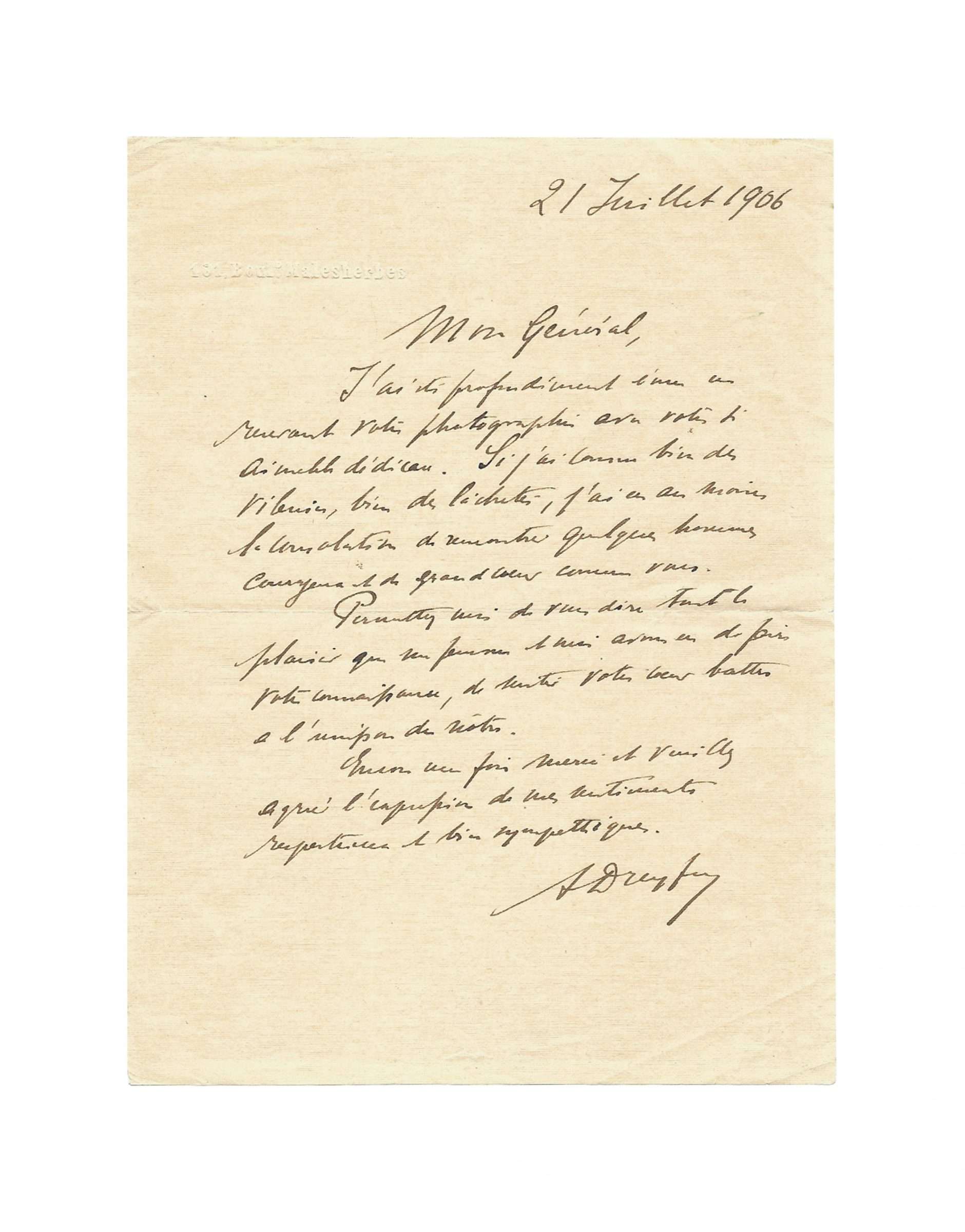[AFFAIRE DREYFUS] DREYFUS, Alfred (1859-1935)
Autograph letter signed « ADreyfus » [to général Percin]
[Paris], 21st July 1906, 1 p. in-8°
« If I have known many villains, many cowardices, I have at least had the consolation of meeting some brave men »
Fact sheet
[AFFAIRE DREYFUS] DREYFUS, Alfred (1859-1935)
Autograph letter signed « ADreyfus » [to général Percin]
[Paris], 21st July 1906, 1 p. in-8°
With his address on letterhead: 101, Boulevard Malesherbes
Historic letter from Captain Dreyfus, written the day after the ceremony for the awarding of his insignia of Knight of the Legion of Honor and a week after the end of his legal marathon, issued by order of the Court of Cassation
« Mon Général,
J’ai été profondément ému en recevant votre photographie avec votre si aimable dédicace. Si j’ai connu bien des vilenies, bien des lâchetés, j’ai eu au moins la consolation de rencontrer quelques hommes courageux et de grand cœur comme vous.
Permettez-moi de vous dire tout le plaisir que ma femme et moi avons eu de faire votre connaissance, de sentir votre cœur battre à l’unisson des nôtres.
Encore une fois merci et veuillez agréer l’expression de mes sentiments respectueux et bien sympathiques.
ADreyfus »
Alfred Dreyfus was declared fully innocent by the Court of Cassation on 12 July 1906, 12 years after he had been unanimously convicted of treason by the court martial. This was followed by the dismissal of his rank, his military degradation on January 5, 1895 in the courtyard of honor of the École Militaire de Paris in front of a hostile crowd, then the perpetual deportation to a fortified enclosure off the Guyanese coast. But Émile Zola’s open letter “J’accuse…!” to President Félix Faure, the unwavering support of his relatives and the many legal twists and turns allowed the captain to regain hope.
On July 13, 1906, Dreyfus was reinstated in the army. On 20 July, on the eve of this letter, he was made a knight of the Legion of Honour “in a ceremony that seemed to close the Affair with an eminently symbolic and political act, in the very institution where he had been degraded twelve years earlier” (V. Duclert, Alfred Dreyfus. L’Honneur d’un patriote. Editions Pluriel, 2016, p. 571). At Dreyfus’s request, the ceremony took place in “the small courtyard of the gardens” and not in the large courtyard where its degradation had taken place twelve years earlier. The following people attended the ceremony: families of Alfred and Lucie, General Picquart (in civilian clothes), Attorney General Baudoin, Anatole France, Joseph Reinach, General and Mrs. Percin, Mr. and Mrs. Armand Dayot, Doctors Paul Reclus and Brissaud, Victor Simon, Alfred Capus, Mrs. Arman de Caillavet, Bernard Lazare’s wife, Isabelle Lazare-Weiler, Commander Emile Mayer, Captain Cassel and many journalists. General Gillain presented him with the insignia. “All this was so moving,” wrote Dreyfus in his Notebooks, “that words are powerless to convey the sensation of it” (p. 264).
Unfortunately, the speed with which this ceremony was organized prevented some of Dreyfus’s defenders from being warned or attending. The absence of General André, one of the main architects of the reopening of the trial, was noticed. On March 27, 1912, Alfred Dreyfus recorded this declaration: “This July 20, 1906, is a beautiful day of reparation for France and the Republic. My business was over. It marked a turning point in humanity, a grandiose step towards an era of immense progress for the ideas of freedom, justice and social solidarity.”
The addressee of this letter was in all likelihood General Percin, who was present on 20 July at the ceremony for the presentation of the insignia of Knight of the Legion of Honour to Commander Dreyfus (see above). On 21 July, he sent the captain an autographed photograph showing him in profile in uniform. Currently kept at the Museum of Art and History of Judaism (gift of Captain Dreyfus’ grandchildren), this photograph bears this dedication: “To Commander Dreyfus Knight of the Legion of Honor, testimony of deep sympathy, General Percin, July 21, 1906”.
Provenance:
M. Vlahakis collection
M. Gaito collection
